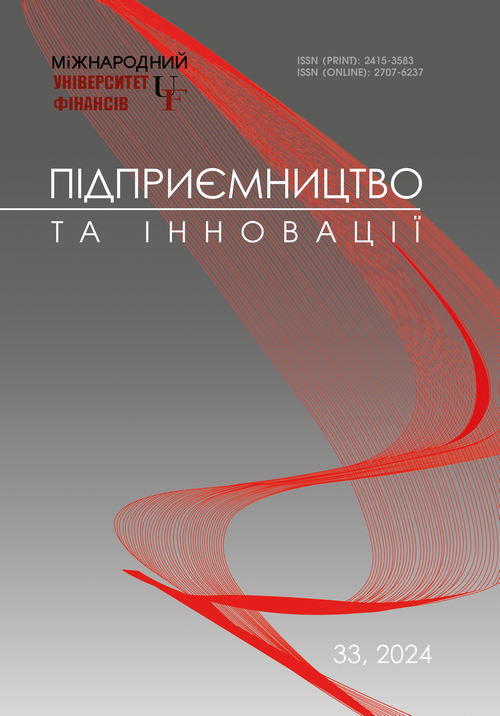THE ROLE OF INTERNAL INFLUENCERS IN STRATEGIC COMMUNICATIONS AND CORPORATE FINANCIAL PERFORMANCE
Abstract
This article explores the phenomenon of internal influencers (employee influencers) as a strategic tool in modern corporate governance, marketing communications, and reputation management. The purpose of the study is to provide both empirical and theoretical justification for the impact of internal influencers on brand trust, target audience engagement, marketing efficiency, and overall corporate financial performance. The research employs a systems-based approach, content analysis of international company cases, and secondary data from open sources and industry reports. Qualitative methods are used to analyze organizational behavior, institutional trust, and branding, and a conceptual model is developed to illustrate the correlation between brand ambassador activity and key business performance indicators. The findings indicate that the strategic involvement of employees in internal influencer activities significantly enhances brand trust, improves customer retention rates, and positively affects core financial metrics, including marketing campaign ROI. Internal influencers serve not only as communication channels but also as carriers of authentic social capital, reinforcing both external brand positioning and internal organizational cohesion. The practical significance of this research lies in its potential for implementing employee advocacy as an integral element of a company’s communication strategy. Its scientific contribution is the formalization of the relationship between endogenous influencer activity and economic performance in the context of the information economy.
References
Aaker, D. A. (1996). Building strong brands. The Free Press.
Bliumska-Danko, K. V., & Orel, A. M. (2022). PR communication algorithm in the activity of small and medium-sized businesses. Scientific Notes of the Vernadsky Taurida National University. Series: Economics and Management, 33(72), 49–54.
Bourdieu, P. (1986). The forms of capital. In J. Richardson (Ed.), Handbook of theory and research for the sociology of education (pp. 241-258). Greenwood.
Coleman, J. S. (1990). Foundations of social theory. Harvard University Press.
De Gilder, D., Schuyt, T. N. M., & Breedijk, M. (2021). Employee engagement in brand advocacy: The role of organizational culture and identity. Journal of Brand Management, 28 (1), 45–60. DOI: https://doi.org/10.1057/s41262-021-00228-1
Edelman. (2024). Edelman Trust Barometer 2024. Available at: https://www.edelman.com/trust-barometer
Freberg, K., Graham, K., McGaughey, K., & Freberg, L. A. (2011). Who are the social media influencers? A study of public perceptions of personality. Public Relations Review, 37(1), 90–92. DOI: https://doi.org/10.1016/j.pubrev.2010.11.001
Gallup. (2023). State of the Global Workplace 2023 Report. Available at: https://www.gallup.com/workplace
Hinge Research Institute. (2022). High Growth Study: Professional Services Edition. Available at: https://hingemarketing.com/library
Karjaluoto, H., Mustonen, N., & Ulkuniemi, P. (2021). The role of employees in business-to-business customer experience management. Industrial Marketing Management, 92, 279–290. DOI: https://doi.org/10.1016/j.indmarman.2020.12.004
Ki, C. W. C., Cuevas, L. M., Chong, S. M., & Lim, H. (2020). Influencer marketing: Social media influencers are human brands attaching to followers and yielding positive marketing results by fulfilling needs. Journal of Retailing and Consumer Services, 55, 102133. DOI: https://doi.org/10.1016/j.jretconser.2020.102133
Kliatchko, J. (2008). Revisiting the IMC construct: A revised definition and four pillars. International Journal of Advertising, 27(1), 133–160. DOI: https://doi.org/10.1080/02650487.2008.11073044
Mael, F., & Ashforth, B. E. (1992). Alums and their alma mater: A partial test of the reformulated model of organizational identification. Journal of Organizational Behavior, 13(2), 103–123. DOI: https://doi.org/10.1002/job.4030130202
Men, L. R., & Tsai, W. H. S. (2016). Public engagement with CEOs on social media: Motivations and relational outcomes. Public Relations Review, 42(5), 932–942. DOI: https://doi.org/10.1016/j.pubrev.2016.10.002
Nahapiet, J., & Ghoshal, S. (1998). Social capital, intellectual capital, and the organizational advantage. Academy of Management Review, 23(2), 242–266. DOI: https://doi.org/10.5465/amr.1998.533225
Nifatova, O. M. (2017). Benchmarking of integrated business structures. Problems of Economics, (2), 217–222. (Translated from Ukrainian)
Schultz, D. E. (2021). Organizational communication and the power of employees as media. International Journal of Advertising, 40(5), 719–721. DOI: https://doi.org/10.1080/02650487.2021.1912282
Schultz, D. E., & Patti, C. H. (2009). The evolution of IMC: IMC in a customer-driven marketplace. Journal of Marketing Communications, 15(2–3), 75–84. DOI: https://doi.org/10.1080/13527260902757506
Sprout Social. (2023). The Sprout Social Index 2023 Edition: Employee Advocacy Trends. Available at: https://sproutsocial.com/insights/data/
Statista. (2023). Influencer marketing spending worldwide 2016–2025. Available at: https://www.statista.com/statistics/1092819/global-influencer-market-size



